Customer Service Outsourcing: A Complete Beginner’s Guide

Running a startup’s support team can be a nightmare, especially when you have limited resources, and you are growing fast.
Emails, support tickets, phone calls, and other inquiries can easily pile up faster than your small in-house crew could handle.
Is there a better way?
The answer is customer service outsourcing.
Many businesses, from eCommerce shops to Fortune 500 firms, find outsourcing their best solution.
If done right, you get to focus on your core business, while a dedicated crew makes sure your customers stay happy.
And that’s what we are going to focus on through this guide, how to outsource customer service effectively. So you can focus on other important aspects of your business.
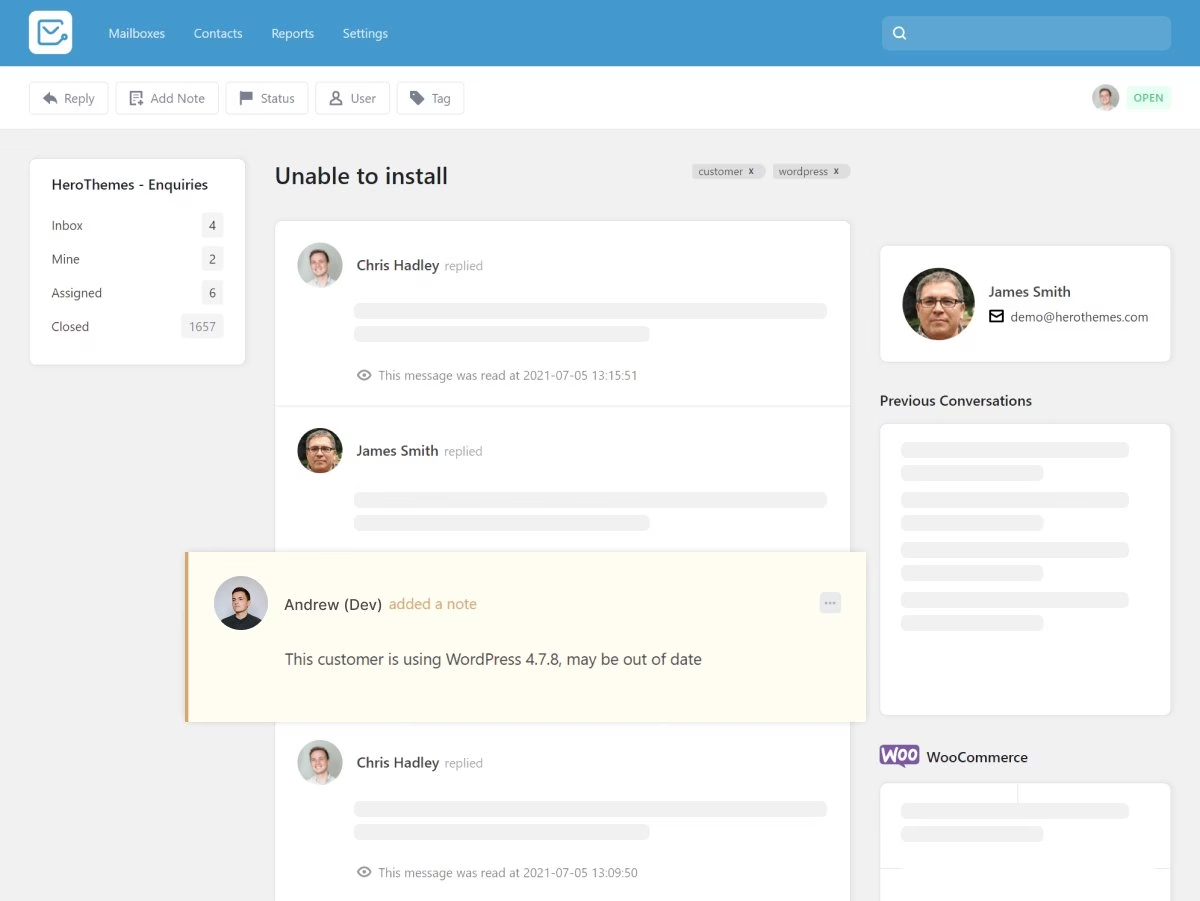
Heroic Inbox
A simple and affordable helpdesk for small businesses.
All plans include unlimited users and tickets.
In This Guide
- What Is Customer Service Outsourcing?
- Types of Customer Service Outsourcing
- Benefits of Outsourcing Customer Service (Why Companies Outsource)
- Drawbacks of Outsourcing Customer Service (Challenges and Cons)
- How to Outsource Customer Service (Step-by-Step Guide)
- Top 5 Customer Service Outsourcing Companies (2025)
What Is Customer Service Outsourcing?
Customer service outsourcing means entrusting your customer support operations to a third-party provider.
In simple terms, you’re hiring an outside team (often called a BPO, for Business Process Outsourcing) to handle interactions with your customers on channels like phone, email, live chat, or social media.

Instead of hiring agents, training them, and managing their growth and results you hire a complete team that is already experienced in what you are looking for, customer service and support.
You only consider the results and budget, which are usually much lower than managing an in-house customer support team.
Ideally, outsourcing customer service is the best option at the beginning of a business.
That said, outsourcing isn’t a cure-all. It requires choosing the right partner and setting them up for success. Customers should notice a difference.
Types of Customer Service Outsourcing
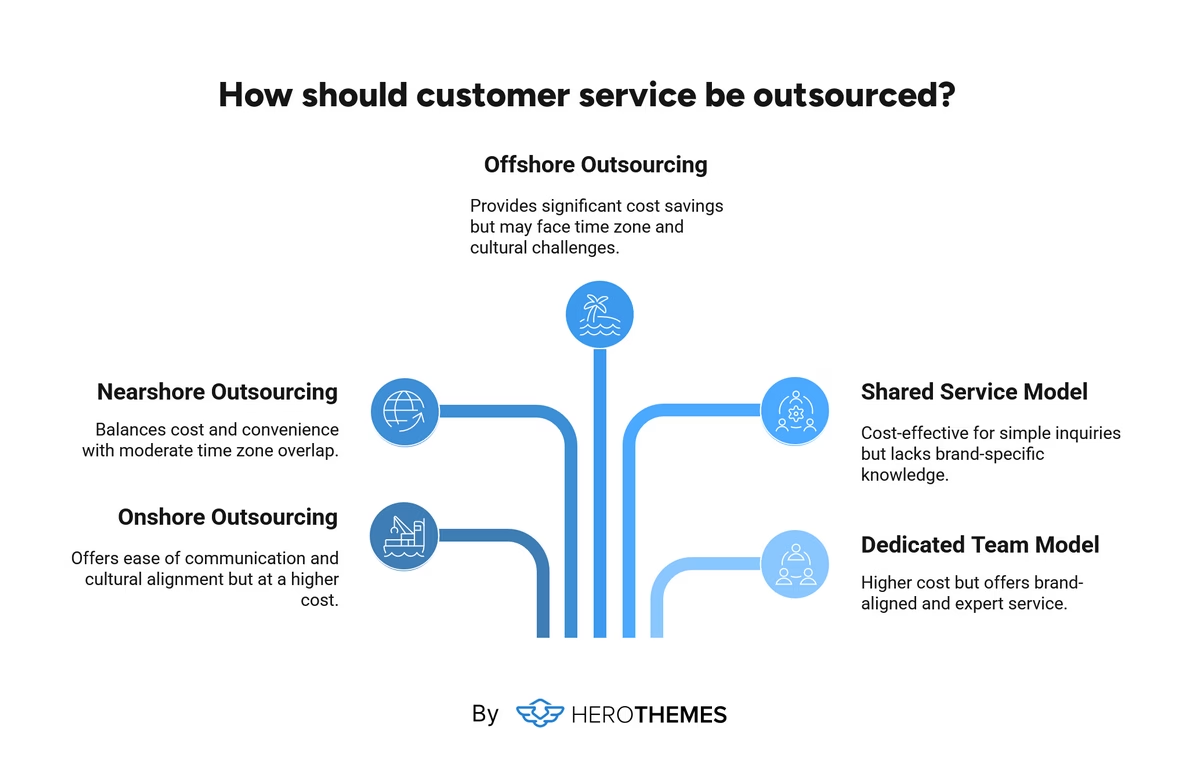
There are several ways you can outsource customer service, and it’s important to choose a setup that fits your needs.
1. By Location: Onshore, Nearshore, or Offshore
This refers to where your outsourced support team is physically located, relative to your business headquarters.
Onshore outsourcing
You hire a service provider in your home country to handle your customer service.
For example, a small US-based company might outsource calls to a larger call center within the US.
Here are the following benefits of onshore outsourcing:
- Ease of communication and cultural alignment
- No language barriers or time-zone headaches
- Agents understand local customers well
The trade-off is cost: onshore services tend to be more expensive because labor rates are higher.
Nearshore outsourcing
This is when you outsource to a nearby country, often one with a similar time zone or cultural affinity.
Nearshore can be a sweet spot between cost and convenience.
- You often get lower labor costs than onshore
- Moderate time-zone overlap and relatively easier travel/communication for training
- Cultural differences exist but are usually manageable
- Many nearshore locations also boast strong bilingual support (like Spanish/English in Latin America) which is great if you serve diverse markets.
Offshore outsourcing
This is the classic scenario when we think about outsourcing.
Sending customer service tasks to a far-away country to leverage lower costs. From places like the Philippines, India, or South Africa.
These regions have a large and skilled workforce, as well as significantly lower wages. This translates into significant cost savings for Western firms. Often help to save 50% or more on customer service labor costs due to wage differences.
The downsides to offshore can include:
- Time zone gaps (middle of the night for you might be daytime for them, and vice versa)
- Potential cultural or language nuances (agents might need training to understand your local slang or customer expectations)
However, top BPO (Business Process Outsourcing) providers mitigate these with training and by hiring well-educated, fluent staff.
2. By Service Model: Shared Team vs. Dedicated Team
This is about whether the agents are exclusively serving your company or handling support for multiple clients at once.
Shared service (multiclient) model
In a shared model, the outsourced agents might be handling customer service for several different companies.
This “fractional” approach is usually very cost-effective because you’re essentially sharing agent time.
The trade-off is that agents in a shared setup might not have deep knowledge of your brand, since they juggle many products and scripts.
It works best for fairly standardized or simple inquiries where agents can follow a clear script or knowledge base.
Dedicated team model
In a dedicated setup, the agents (or at least a core group of them) are 100% focused on your company’s customers and nobody else.
You get a tailor-made support team that learns your products, policies, and culture in depth. This model costs more, but it yields higher-quality, brand-aligned service.
Dedicated agents can develop expertise in your offerings, use your company’s tone of voice, and often handle more complex issues because of that familiarity.
3. By Function or Channel
How about just outsourcing customer service for pre-sales questions? That’s also possible.
Common outsourced customer service functions include:
- Call center services: Call center outsourcing is popular because running a phone support operation in-house is resource-intensive, and specialized call centers can manage high volumes of calls, provide 24/7 phone coverage, and often resolve issues faster by using standardized processes.
- Live chat and email support: These channels don’t require voice communication, which makes them easier to offshore to agents with strong written English.
Chat, in particular, demands fast response times and an outsourced team dedicated to live chat can ensure no customer waits more than a minute or two, even at 3 AM on a Saturday. - Technical support / Help desk: If you offer tech products or software, you may want to consider outsourcing Tier 1 tech support for initial troubleshooting calls or chats. They can easily handle the common issues (“Have you tried restarting?”) and only escalate to your in-house team for the trickiest problems.
- Outbound support and telemarketing: Outsource outbound support for things like lead follow-ups, customer satisfaction surveys, or upselling/cross-selling calls.
Explore: Upsell Email Subject Lines - Social media customer care: Specialized outsourcing teams can monitor your social media mentions and DMs, responding to customer service issues posted there.
- Multilingual support: If you have a global customer base, you might need support in multiple languages.
Benefits of Outsourcing Customer Service (Why Companies Outsource)
Why do so many companies outsource their customer service?
The short answer: to gain advantages in cost, efficiency, and expertise.
1. Cost Savings
This is the number one driver behind outsourcing, especially for small businesses on a budget.
Hiring and training in-house support staff is expensive. You have salaries, benefits, office space, equipment, software licenses, etc.
Outsourcing can dramatically lower these expenses.
How much does it cost to outsource customer service?
An in-house support agent in the U.S. costs around $3,630 per month, whereas an outsourced agent (with strong English written skills) will cost only $400–$700 per month.
If you are outsourcing to the U.S. or Europe, you can easily save 50-60%.
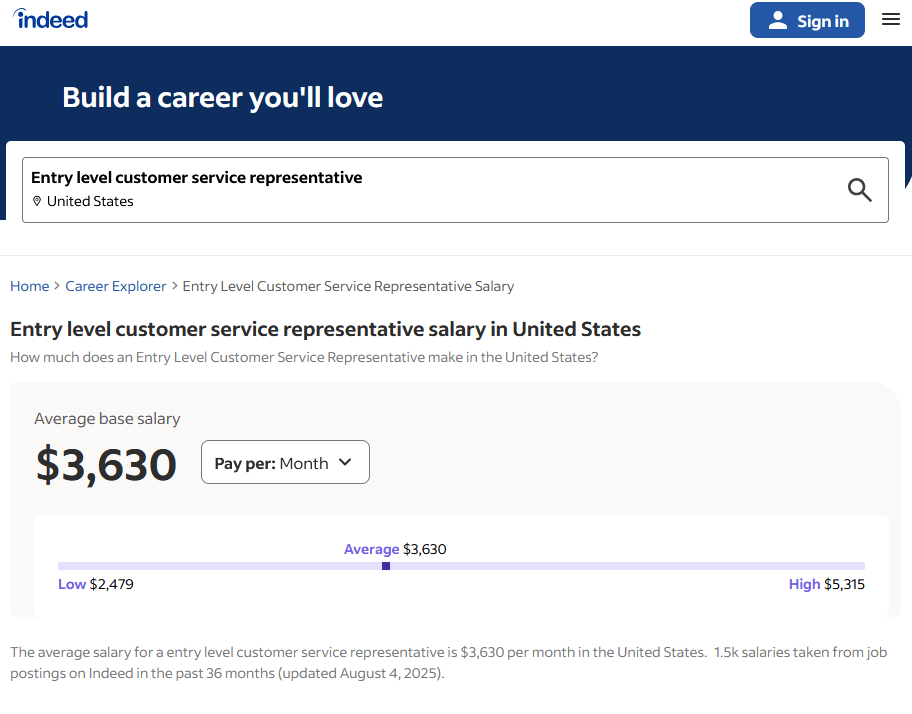
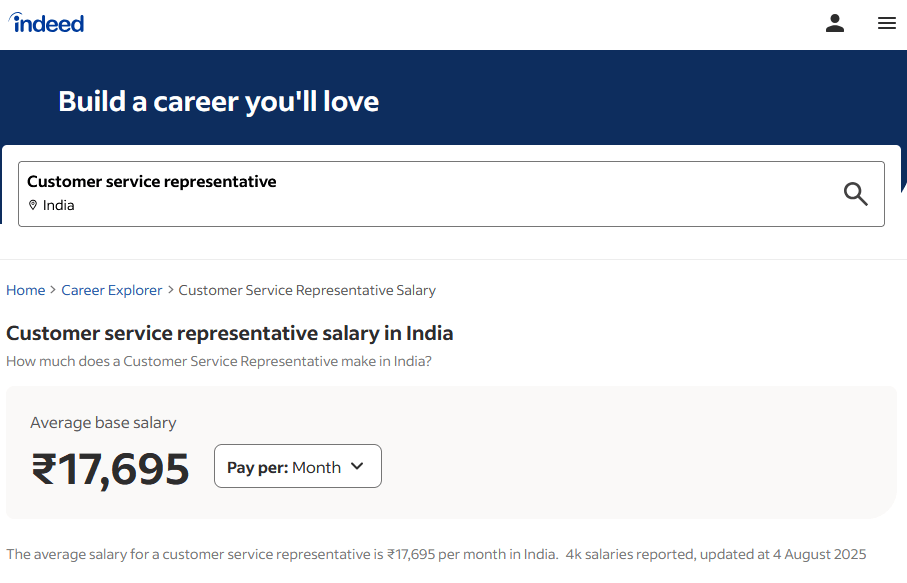
To give you a better idea of the cost of outsourcing, here’s a quick comparison of the typical hourly costs of outsourced customer service by region:
- Philippines / India: ~$7 – $15 per hour.
- Eastern Europe: ~$15 – $25 per hour.
- Latin America: ~$10 – $20 per hour.
- United States / Canada: ~$25 – $35+ per hour.
The above salary range is estimated based on personal experience and available salary data.
2. Scalability and Flexibility
Outsourcing lets you scale your support team up or down quickly without the usual hassle.
If you experience seasonal spikes or sudden growth, an outsourcing partner can add more agents to your project in days or weeks, not the months it would take you to hire and train new staff.
Conversely, if volumes drop, you can often scale down and not pay for idle staff.
3. 24/7 Coverage and Faster Response Times
Today’s customers expect instant, round-the-clock service. Meeting that expectation in-house can be extremely challenging. Unless you have people working graveyard shifts, which brings its own costs and morale issues.
One big benefit of outsourcing is the ability to provide 24/7 customer support by leveraging teams in different time zones. While your U.S. office sleeps, a team in Asia can handle queries, and vice versa.
4. Focus on Core Business
Every hour you or your key employees spend fielding support calls is an hour not spent on growing the business.
By outsourcing customer service, you free up your in-house team to concentrate on what you do best. Whether that’s developing new products, crafting marketing campaigns, or closing sales.
5. Access to Expertise and Technology
Reputable outsourcing providers bring a ton of experience and specialized tools to the table.
They’ve likely worked with multiple companies in your industry, trained agents on similar products, and learned best practices along the way.
By outsourcing, you tap into that expertise immediately, rather than reinventing the wheel.
6. Improved Service Levels (if managed well)
The combination of the above factors often leads to higher customer satisfaction and consistency.
With outsourcing, you can set Service Level Agreements (SLAs) and Key Performance Indicators (KPIs) that the provider is contractually obliged to meet.
7. Multi-Channel and Multilingual Support
As your business grows, you may need to support new channels, such as live chat, SMS, or WhatsApp. You may also need to support new languages if you start selling in Europe or Asia, for example.
Hiring and training for those capabilities can be tough. Outsourcing shines here because vendors already have these capabilities on deck.
Drawbacks of Outsourcing Customer Service (Challenges and Cons)
While there are plenty of good reasons to outsource, it’s only fair to talk about the flip side:
1. Loss of Direct Control
This is one of the biggest hesitations companies have. When your support team is in-house, you have full control over hiring, training, quality monitoring, and day-to-day operations.
When you outsource, you inherently give up some of that control.
“Outsourcing can feel like trusting someone with your child.” You have to make sure you’ve picked a reliable babysitter, because you won’t be there watching every interaction.
2. Potential Quality and Brand Consistency Issues
Your customers likely have a certain expectation of service quality and brand tone from you.
Outsourced agents, especially if shared across clients or located in a different culture, may not embody your brand’s voice or values as strongly as an in-house team member.
3. Communication and Cultural Barriers
When outsourcing overseas, differences in language proficiency, accent, or cultural context can lead to misunderstandings or a less smooth customer experience.
Even if outsourced agents speak your language fluently, they might not catch certain idioms, humor, or regional issues that local customers mention.
4. Customer Perception and Backlash
Sometimes customers realize a company has outsourced support and might not be happy about it.
You’ve probably heard comments like “Ugh, I got some call center rep who knew nothing, I wish I could just talk to the company directly.”
5. Integration and Knowledge Transfer Effort
To get an external team up to speed, you have to invest time in knowledge transfer.
This means providing extensive documentation, running training sessions, and possibly building new processes so the outsourcers can communicate with your internal team for escalations.
In the beginning, expect a learning curve where the outsourced agents might take longer to solve issues or escalate more cases back to you until they become proficient.
6. Shared Agents / Priority Issues
If you chose a shared agent model to save costs, note that those agents are juggling multiple clients. That can mean at busy times your customers might wait because the agent is handling another company’s call.
One way around this con is negotiating a dedicated team (even if small) or at least dedicated points of contact, so you have someone accountable for your account’s performance.
7. Dependency and Lock-In
Once you outsource, you become somewhat dependent on that provider.
If things go wrong, say the provider has a high staff turnover, or their quality drops, or they raise prices – switching to another vendor or bringing support back in-house can be disruptive.
You may lose some continuity or even data (imagine the outsourcer ran the ticketing software and you have to migrate records).
Despite these challenges, many companies successfully outsource and keep customers happy. The key is being aware of the pitfalls and addressing them proactively. Here are a few quick tips to overcome cons:
How to Outsource Customer Service (Step-by-Step Guide)
So, you’ve decided you want to explore outsourcing your customer support. How do you actually do it?
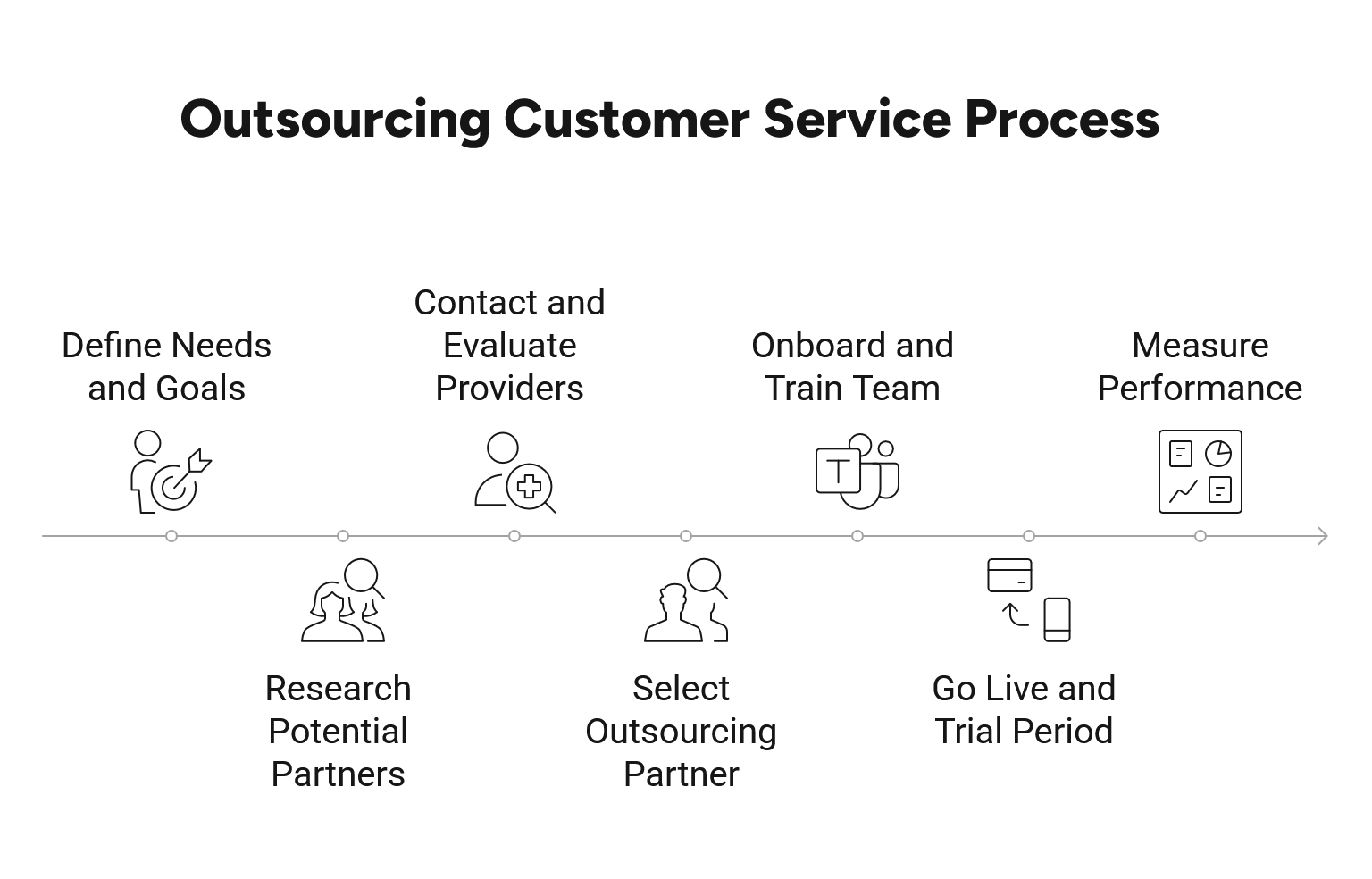
Step 1: Define Your Needs and Goals
Start by clearly outlining what you want to outsource and why. Take stock of your current support situation:
- What channels do you need help with? Examples: Phone, email, live chat, social media DMs. Maybe your small business can handle emails fine, but calls are tying you up, or you want to add 24/7 chat without hiring graveyard shift staff.
- When do you need coverage? Identifying whether you need full-time coverage or just nights/weekends will influence which partner can accommodate you.
- Volume of interactions: How many calls or tickets do you get per day on average? per month? Are there predictable peaks (seasonal, product launches, sales)?
- Skills required: Outline any special skills or knowledge agents will need. For example, do they need to know a particular software, speak multiple languages, or have technical troubleshooting ability?
- Quality expectations: Set your goals: “I want customer emails answered within 4 hours and calls picked up within 1 minute.” Knowing the service levels you aim to provide will guide your discussion with potential partners.
- Budget: Are you outsourcing mainly to save money? If so, have a sense of what would make it “worth it” financially (e.g., you want to spend 30% less than your in-house option).
Essentially, paint a clear picture of the support function you want to outsource.
Step 2: Research Potential Outsourcing Partners
Now, you know your customer service requirements, it’s time to find companies that offer customer service outsourcing which aligns with your needs:
- Ask for referrals or advice from your network. If you know other entrepreneurs or managers who have outsourced support, ask about their experiences and if they recommend any providers. (Top Referral Email Subject Lines for Warm Introductions)
- Search online directories and reviews. Websites like Clutch.co, G2, or even Google searches can be useful.
- Consider the location and size of the provider. If you decide you want onshore, your search is domestic. If offshore, you might specifically look for proven centers in the Philippines, India, Latin America, etc.
- Make a shortlist of maybe 3–6 potential partners that look promising. Visit their websites, note down what services they offer, their selling points, and any obvious alignments (or gaps) with your needs.
Step 3: Contact and Evaluate Providers (RFP & Questions)
Now it’s time to reach out to your shortlisted outsourcing providers.
- Prepare an RFP or inquiry. You don’t necessarily need a formal Request for Proposal (RFP) if you’re a smaller operation, but do prepare to communicate your requirements clearly.
Explore: Best Inquiry Email Subject Lines - Ask the right questions:
- How long have you been in business and what’s your track record?
- Do you have experience in our industry or with similar products?
- What other clients do you serve, and can you provide references?
- How do you handle training for our account, and will you adapt to our brand voice?
- What is your agent turnover rate and how do you ensure staffing stability?
- How do you monitor quality and report on performance?
- What’s your capacity for scaling if our needs grow?
- How do we integrate your team with our tools?
- What are your security and compliance measures?
- How do you price your services – per hour, per ticket, flat rate? and are there any setup fees or minimum commitments?
- Gauge their communication: Pay attention to how responsive and clear each provider is during this phase. If they take a week to reply to your email or seem disorganized on a call, that might reflect how they operate.
- Compare proposals: After your inquiries, you’ll likely get proposals or quotes from each candidate. Compare them not just on price, but on the value and fit.
Step 4: Select Your Outsourcing Partner
Decision time!
Using all the information gathered, pick the provider that best meets your needs and gives you confidence.
Here are some recommendations while finalizing outsourcing deal:
- Read the contract or agreement carefully. Ensure the SLA targets you need are explicitly stated. Example:
- 85% of calls answered in 30 seconds
- First response to emails within 1 hour
- Clarify the pricing model and volume commitments. If they charge per hour, how do they count hours? If per ticket, what if one ticket turns into a lengthy back-and-forth, is it still one ticket or many?
- Plan the transition timeline. Agree on a start date and any ramp-up period. Sometimes you won’t flip the switch 100% on day one; you might phase in over a few weeks.
Step 5: Onboard and Train the Outsourced Team
This is a critical step for success. Don’t skip out on giving the new team a proper education about your business. Treat them as you would new hires joining your own staff:
- Provide all necessary documentation and tools. This includes product manuals, FAQ answers, troubleshooting guides, your company’s tone/voice guidelines, brand dos and don’ts, etc.
If you already have an internal knowledge base or help center articles for customers, share those. - Host training sessions. Don’t just email docs and hope for the best. Schedule training calls.
- Train on your software systems. Ensure the agents know how to navigate any CRM or order system they’ll need.
- Highlight your company culture and values. Even though they’re external, it’s great to inspire the team with your mission.
- Set up communication channels.
Effective onboarding is front-loaded work, but it pays off by setting the foundation for quality service.
As a rule of thumb, don’t assume anything – if there’s any knowledge critical to helping your customers, proactively share it.
Step 6: Go Live and Start with a Trial Period
It’s showtime! The outsourced team starts handling customer contacts. It’s wise to treat the first couple of weeks as a trial or soft launch:
- Consider notifying your customers in a subtle way if a different procedure is in place.
- Monitor closely in the early phase. Check tickets for accuracy. If you have recordings of calls or transcripts of chats (most systems provide this), review a good sample daily. Don’t view this as spying; it’s QA to ensure your customers are getting proper help and the agents aren’t struggling.
- Keep communication lines super open. You can even set up a daily quick call or chat check-in for the first week between you and the outsource supervisor to address any burning questions.
- Gather feedback from customers and the agents.
Starting with a “trial mindset” helps because you can catch and correct issues early. It’s normal to do some tweaking, maybe you realize the refund process needs a better walkthrough, or customers are asking about a feature the training didn’t cover in depth.
Use this time to refine.
Step 7: Measure Performance and Provide Ongoing Support
Remember, outsourcing is not “set it and forget it.” Here’s how to keep everything on track:
- Track key metrics regularly. Such as:
- Average response time
- Average handle time
- First contact resolution rate
- Customer satisfaction (CSAT) or Net Promoter Score (NPS) from surveys
- Backlog of tickets, etc.
- Regular business reviews: Set up a recurring meeting (bi-weekly or monthly) to review performance and calibrate.
- Continue to update the knowledge base and training. Make sure whenever you roll out a new feature, policy, or pricing, the outsourced team is among the first to know.
- Foster team spirit and motivation: Recognize good performance. If an agent gets a shout-out from a customer, pass on the praise, maybe even send a small reward.
Remember, these folks are representing you every day. Celebrating their successes (Agent of the Month, etc.) or including them in all-hands calls occasionally can keep morale high. (The 4 Best Email Subject Lines for Celebrating Milestones) - Have a plan for issues/escalations: Ensure the outsourcer has an escalation path to you for urgent issues (and you to them).
- Evaluate and adjust the partnership as needed.
By following these steps, you dramatically increase the likelihood that your customer service outsourcing venture will succeed.
Many businesses that fail at outsourcing do so because they skipped the planning or the oversight.
You’re not going to be one of those—you’ve got the blueprint now.
Top 5 Customer Service Outsourcing Companies (2025)
Who is the best in the business to help me with my customer service?
Depend on your specific needs, so consider these as a starting point for your research.
1. Teleperformance
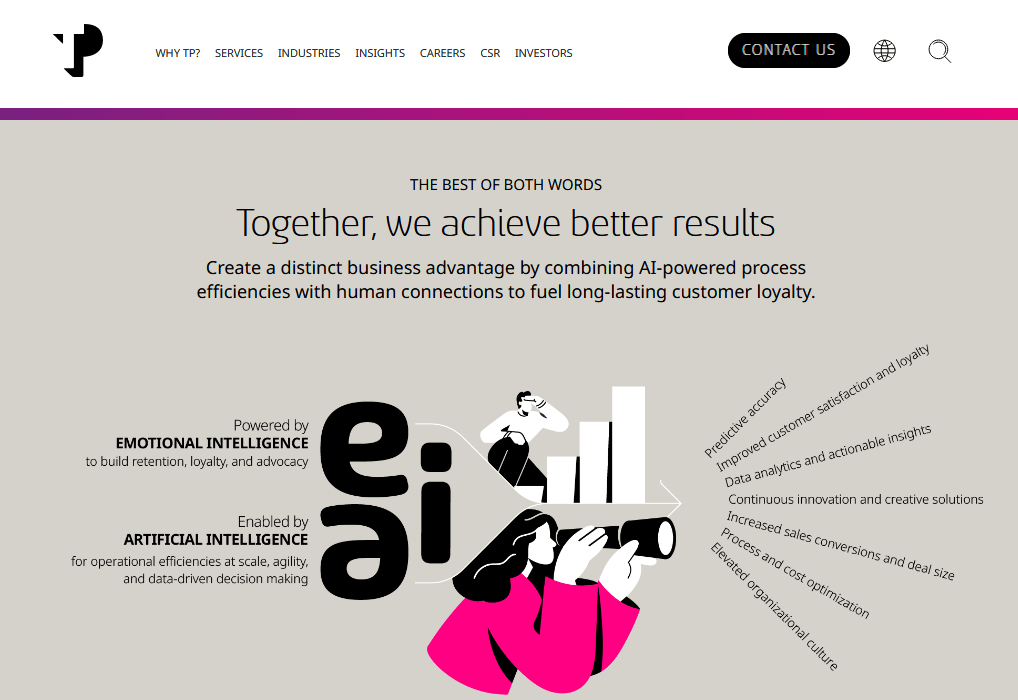
Teleperformance is the world’s largest customer experience (CX) outsourcing provider, operating in over 90 countries with a workforce of roughly 420,000+ agents globally.
Teleperformance is known for handling massive support operations and offering omnichannel support (voice, chat, social, you name it) in dozens of languages.
If you need a truly global reach and deep expertise, this is a go-to, though smaller clients might find them a bit heavy-duty.
2. Concentrix

Concentrix is another industry giant with tens of thousands of employees worldwide.
They focus on omnichannel customer experience and are known for being tech-savvy and innovative.
Concentrix often touts its automation and AI integration in support (for example, using AI to assist agents or provide self-service).
If you’re a mid-to-large company looking for a partner who can both run your support and help improve it strategically, Concentrix is a top contender.
3. Foundever (formerly Sitel Group)
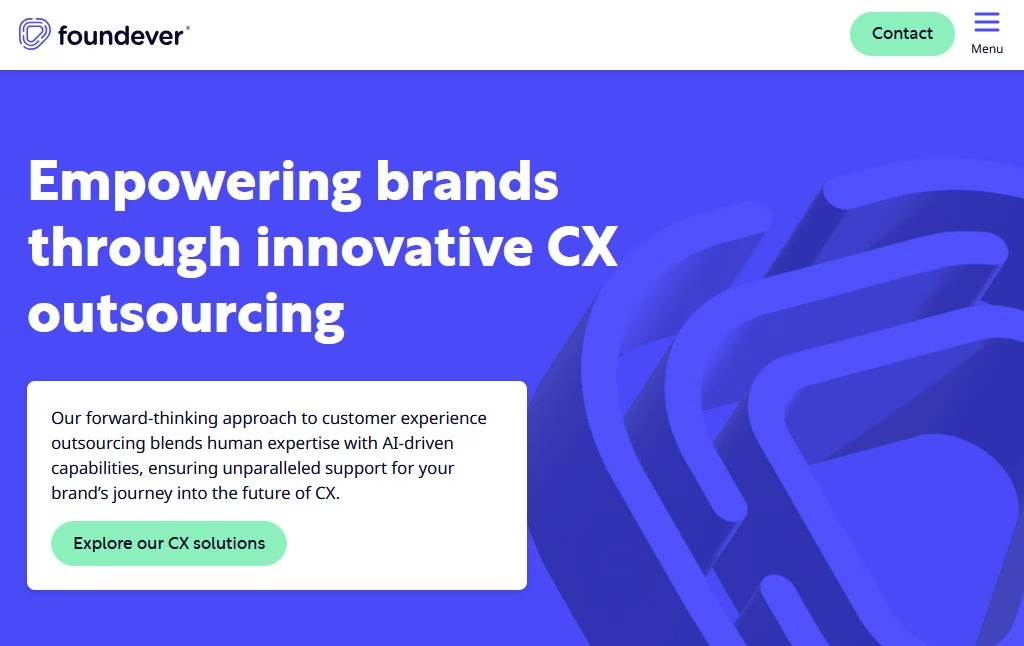
Foundever is the new brand after Sitel Group merged with Sykes. Combined, they form a major global player in contact center outsourcing.
Foundever emphasizes a mix of human and AI-driven solutions, and a presence in 40+ countries.
A strength of Foundever/Sitel has been their flexibility in staffing models and strong performance in sectors like retail, travel, and healthcare support.
4. Alorica

Alorica is a large U.S.-based outsourcer with a global footprint, particularly strong in North America, Latin America, and Asia.
They’re known for customer care and technical support across industries like telecom, eCommerce, and consumer electronics.
5. TTEC (TeleTech)

TTEC is a global CX solutions company that offers outsourced customer care, CX consulting, and digital solutions. They pride themselves on rapid deployment and secure operations.
TTEC has a platform called Humanify® for omnichannel communications and often integrates customer data analytics into their service to help clients improve. And with a strong presence in the Americas and Europe.
If you’re interested in an outsourcer that can also help optimize your customer experience (not just run it), TTEC has that consulting arm alongside the call center services.
It is crucial to choose the right outsourcing company because it can determine whether or not your outsourcing venture is successful.
So take your time, get proposals, and even ask for a trial if available.
Final Thoughts
In closing, customer service outsourcing is a powerful strategy for small businesses to large enterprises.
It’s about working smarter: leveraging global talent, extending your support hours, and doing right by your customers without breaking the bank or burning out your internal team.
If you decide to outsource, go in with clear goals, choose your partner carefully, and don’t skimp on the onboarding and communication.
Treat your outsourced team as part of your own, and they will reward you by treating your customers as their own.
Here’s to happier customers and a more streamlined business for you!




